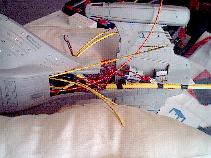|
I knew I was dealing with
tight spaces, but I didn't appreciate just how tight. Suddenly I
was dealing with threading window fibre through wires, ensuring enough
space was left for assembly and trying not to snap any if the window
fibres.
I lost and re-installed
countless window fibres, the total loss count being about seven.
I began by tightening up
the space - putting coils in the wires so they would compress
gracefully and bending them to allow space. I then marked where
I wanted the window fibres to go on the port side, and started
drilling.
Unfortunately the micro
drill had long broken so I had to use the Dremel tool to hold the
hair-thin drill bit, and remembering that I had difficulty on the
starboard side with making the windows too large I experimented on the
Enterprise-D and found that using the Dremel (turning at a minimum of
5,000 RPM) it melted the plastic practically on contact. So, I
had to drill the windows not just precisely, but fast. Turns out
I had just a couple of windows that weren't okay, but most of them I
had to follow up with the drill bit and pliers because the hole sealed
up with melted plastic after pulling out the bit!
It was very tedious.
 After the holes were prepared, I then ran the window fibre into the
holes backwards and threaded them through the wires and circuit board,
guiding them to the aft of the ship for mounting to the fibre drivers.
I then put the starboard section of the ship closer to the main hull
for assembly.
After the holes were prepared, I then ran the window fibre into the
holes backwards and threaded them through the wires and circuit board,
guiding them to the aft of the ship for mounting to the fibre drivers.
I then put the starboard section of the ship closer to the main hull
for assembly.
|

